+ Open data
Open data
- Basic information
Basic information
| Entry | Database: PDB / ID: 1nan | ||||||
|---|---|---|---|---|---|---|---|
| Title | MCH CLASS I H-2KB MOLECULE COMPLEXED WITH PBM1 PEPTIDE | ||||||
 Components Components |
| ||||||
 Keywords Keywords | IMMUNE SYSTEM / class I MHC / H-2Kb / alloreactivity / crossreactivity | ||||||
| Function / homology |  Function and homology information Function and homology informationEndosomal/Vacuolar pathway / DAP12 interactions / Antigen Presentation: Folding, assembly and peptide loading of class I MHC / ER-Phagosome pathway / DAP12 signaling / Immunoregulatory interactions between a Lymphoid and a non-Lymphoid cell / antigen processing and presentation of exogenous peptide antigen via MHC class I / inner ear development / antigen processing and presentation of endogenous peptide antigen via MHC class I via ER pathway, TAP-dependent / positive regulation of phosphorylation ...Endosomal/Vacuolar pathway / DAP12 interactions / Antigen Presentation: Folding, assembly and peptide loading of class I MHC / ER-Phagosome pathway / DAP12 signaling / Immunoregulatory interactions between a Lymphoid and a non-Lymphoid cell / antigen processing and presentation of exogenous peptide antigen via MHC class I / inner ear development / antigen processing and presentation of endogenous peptide antigen via MHC class I via ER pathway, TAP-dependent / positive regulation of phosphorylation / cellular defense response / Neutrophil degranulation / lumenal side of endoplasmic reticulum membrane / cellular response to iron(III) ion / negative regulation of forebrain neuron differentiation / antigen processing and presentation of exogenous protein antigen via MHC class Ib, TAP-dependent / iron ion transport / peptide antigen assembly with MHC class I protein complex / regulation of iron ion transport / regulation of erythrocyte differentiation / HFE-transferrin receptor complex / response to molecule of bacterial origin / MHC class I peptide loading complex / T cell mediated cytotoxicity / positive regulation of T cell cytokine production / antigen processing and presentation of endogenous peptide antigen via MHC class I / MHC class I protein complex / peptide antigen binding / positive regulation of receptor-mediated endocytosis / negative regulation of neurogenesis / cellular response to nicotine / positive regulation of T cell mediated cytotoxicity / multicellular organismal-level iron ion homeostasis / phagocytic vesicle membrane / negative regulation of epithelial cell proliferation / sensory perception of smell / positive regulation of cellular senescence / T cell differentiation in thymus / negative regulation of neuron projection development / protein refolding / protein homotetramerization / amyloid fibril formation / intracellular iron ion homeostasis / learning or memory / defense response to bacterium / external side of plasma membrane / structural molecule activity / Golgi apparatus / protein homodimerization activity / extracellular space / identical protein binding / cytoplasm / cytosol Similarity search - Function | ||||||
| Biological species |  | ||||||
| Method |  X-RAY DIFFRACTION / X-RAY DIFFRACTION /  SYNCHROTRON / SYNCHROTRON /  MOLECULAR REPLACEMENT / Resolution: 2.3 Å MOLECULAR REPLACEMENT / Resolution: 2.3 Å | ||||||
 Authors Authors | Reiser, J.-B. / Darnault, C. / Gregoire, C. / Mosser, T. / Mazza, G. / Kearnay, A. / van der Merwe, P.A. / Fontecilla-Camps, J.C. / Housset, D. / Malissen, B. | ||||||
 Citation Citation |  Journal: Nat.Immunol. / Year: 2003 Journal: Nat.Immunol. / Year: 2003Title: CDR3 loop flexibility contributes to the degeneracy of TCR recognition Authors: Reiser, J.-B. / Darnault, C. / Gregoire, C. / Mosser, T. / Mazza, G. / Kearnay, A. / van der Merwe, P.A. / Fontecilla-Camps, J.C. / Housset, D. / Malissen, B. #1:  Journal: Immunity / Year: 2002 Journal: Immunity / Year: 2002Title: A T-Cell Receptor Cdr3Beta Loop Undergoes Conformational Changes of Unprecedented Magnitude Upon Binding to a Peptide/Mhc Class I Complex Authors: Reiser, J.-B. / Gregoire, C. / Darnault, C. / Mosser, T. / Guimezanes, A. / Schmitt-Verhulst, A.-M. / Fontecilla-Camps, J.C. / Mazza, G. / Malissen, B. / Housset, D. | ||||||
| History |
|
- Structure visualization
Structure visualization
| Structure viewer | Molecule:  Molmil Molmil Jmol/JSmol Jmol/JSmol |
|---|
- Downloads & links
Downloads & links
- Download
Download
| PDBx/mmCIF format |  1nan.cif.gz 1nan.cif.gz | 166 KB | Display |  PDBx/mmCIF format PDBx/mmCIF format |
|---|---|---|---|---|
| PDB format |  pdb1nan.ent.gz pdb1nan.ent.gz | 132.8 KB | Display |  PDB format PDB format |
| PDBx/mmJSON format |  1nan.json.gz 1nan.json.gz | Tree view |  PDBx/mmJSON format PDBx/mmJSON format | |
| Others |  Other downloads Other downloads |
-Validation report
| Summary document |  1nan_validation.pdf.gz 1nan_validation.pdf.gz | 466.4 KB | Display |  wwPDB validaton report wwPDB validaton report |
|---|---|---|---|---|
| Full document |  1nan_full_validation.pdf.gz 1nan_full_validation.pdf.gz | 489.2 KB | Display | |
| Data in XML |  1nan_validation.xml.gz 1nan_validation.xml.gz | 31.3 KB | Display | |
| Data in CIF |  1nan_validation.cif.gz 1nan_validation.cif.gz | 43.1 KB | Display | |
| Arichive directory |  https://data.pdbj.org/pub/pdb/validation_reports/na/1nan https://data.pdbj.org/pub/pdb/validation_reports/na/1nan ftp://data.pdbj.org/pub/pdb/validation_reports/na/1nan ftp://data.pdbj.org/pub/pdb/validation_reports/na/1nan | HTTPS FTP |
-Related structure data
| Related structure data | 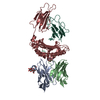 1namC  1kj3S S: Starting model for refinement C: citing same article ( |
|---|---|
| Similar structure data |
- Links
Links
- Assembly
Assembly
| Deposited unit | 
| ||||||||
|---|---|---|---|---|---|---|---|---|---|
| 1 |
| ||||||||
| Unit cell |
|
- Components
Components
| #1: Protein | Mass: 32068.777 Da / Num. of mol.: 2 / Fragment: Extracellular Domains (alpha1, alpha2, alpha3) Source method: isolated from a genetically manipulated source Source: (gene. exp.)   #2: Protein | Mass: 11704.359 Da / Num. of mol.: 2 Source method: isolated from a genetically manipulated source Source: (gene. exp.)   #3: Protein/peptide | Mass: 983.076 Da / Num. of mol.: 2 / Source method: obtained synthetically Details: The peptide was chemically synthesized. The sequence is naturally found in mus muculus (mouse). References: GenBank: 13385376, UniProt: Q8CDD8*PLUS #4: Water | ChemComp-HOH / | Has protein modification | Y | |
|---|
-Experimental details
-Experiment
| Experiment | Method:  X-RAY DIFFRACTION / Number of used crystals: 1 X-RAY DIFFRACTION / Number of used crystals: 1 |
|---|
- Sample preparation
Sample preparation
| Crystal | Density Matthews: 2.68 Å3/Da / Density % sol: 53.73 % | ||||||||||||||||||||||||||||||||||||||||||
|---|---|---|---|---|---|---|---|---|---|---|---|---|---|---|---|---|---|---|---|---|---|---|---|---|---|---|---|---|---|---|---|---|---|---|---|---|---|---|---|---|---|---|---|
| Crystal grow | Temperature: 293 K / Method: vapor diffusion, hanging drop / pH: 6.8 Details: PEG6000 16-17%, NaAc 0.2M, NaCl 0.3M, Mes 0.1M, pH 6.8, VAPOR DIFFUSION, HANGING DROP, temperature 293K | ||||||||||||||||||||||||||||||||||||||||||
| Crystal grow | *PLUS Temperature: 20 ℃ | ||||||||||||||||||||||||||||||||||||||||||
| Components of the solutions | *PLUS
|
-Data collection
| Diffraction | Mean temperature: 100 K |
|---|---|
| Diffraction source | Source:  SYNCHROTRON / Site: SYNCHROTRON / Site:  ESRF ESRF  / Beamline: ID14-3 / Wavelength: 0.94 Å / Beamline: ID14-3 / Wavelength: 0.94 Å |
| Detector | Type: MARRESEARCH / Detector: CCD / Date: Jun 15, 1999 |
| Radiation | Protocol: SINGLE WAVELENGTH / Monochromatic (M) / Laue (L): M / Scattering type: x-ray |
| Radiation wavelength | Wavelength: 0.94 Å / Relative weight: 1 |
| Reflection | Resolution: 2.3→61.26 Å / Num. all: 41983 / Num. obs: 41983 / % possible obs: 98.9 % / Observed criterion σ(F): 0 / Observed criterion σ(I): 0 / Redundancy: 5.9 % / Biso Wilson estimate: 44.8 Å2 / Rsym value: 0.067 / Net I/σ(I): 7.1 |
| Reflection shell | Resolution: 2.3→2.42 Å / Redundancy: 4.1 % / Mean I/σ(I) obs: 2.5 / Num. unique all: 5761 / Rsym value: 0.272 / % possible all: 97.3 |
| Reflection | *PLUS Lowest resolution: 61.3 Å / % possible obs: 98.6 % / Redundancy: 6 % / Rmerge(I) obs: 0.067 |
| Reflection shell | *PLUS % possible obs: 97 % / Rmerge(I) obs: 0.27 |
- Processing
Processing
| Software |
| ||||||||||||||||||||
|---|---|---|---|---|---|---|---|---|---|---|---|---|---|---|---|---|---|---|---|---|---|
| Refinement | Method to determine structure:  MOLECULAR REPLACEMENT MOLECULAR REPLACEMENTStarting model: PDB ENTRY 1KJ3 Resolution: 2.3→12 Å / Isotropic thermal model: ISOTROPIC / Cross valid method: THROUGHOUT / σ(F): 0 / Stereochemistry target values: Engh & Huber
| ||||||||||||||||||||
| Displacement parameters | Biso mean: 42.3 Å2
| ||||||||||||||||||||
| Refinement step | Cycle: LAST / Resolution: 2.3→12 Å
| ||||||||||||||||||||
| Refine LS restraints |
| ||||||||||||||||||||
| LS refinement shell | Resolution: 2.3→2.36 Å
| ||||||||||||||||||||
| Refinement | *PLUS Rfactor Rfree: 0.278 | ||||||||||||||||||||
| Solvent computation | *PLUS | ||||||||||||||||||||
| Displacement parameters | *PLUS | ||||||||||||||||||||
| Refine LS restraints | *PLUS
|
 Movie
Movie Controller
Controller






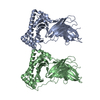
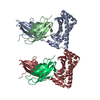

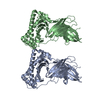
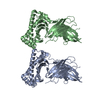
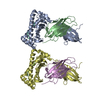
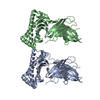
 PDBj
PDBj














